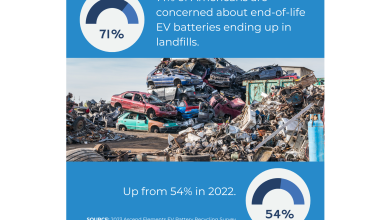EVs in shared mobility to grow 50% annually by 2032

September 19, 2023 – Boulder, Colo. – A new report from Guidehouse Insights examines the transition of shared mobility services offerings from internal combustion engine (ICE) powered vehicles to EVs. The report projects that the number of EVs in mobility services on the road will experience an overall compound annual growth rate of 49.6%, starting from an estimated 7.9 million EVs in 2023. This growth is expected to reach an estimated 299.3 million EVs by 2032.
The EV market, buoyed by government regulations and incentives, is rapidly growing around the world. Correspondingly, the EV charging infrastructure market is also expanding due to environmental, social, and corporate governance (ESG) concerns. Municipal governments in densely populated areas are instituting their own laws along with national government initiatives. These laws aim to cut down on tailpipe emissions.
“EVs are expected to increase as a proportion of shared mobility services vehicles and to grow in overall number of shared mobility services vehicles,” says Elizabeth Wilson, research analyst with Guidehouse Insights. “Individual car ownership is likely to decrease as city dwellers become more aware of rising ownership costs. They are also becoming more conscious of their carbon footprint and exploring less costly multimodal transportation options. These consumers will likely look to shared mobility vehicles—including ride-hailing, carshare programs, and corporate leasing—to meet their car needs.”
Shared mobility vehicles must follow national and subnational regulations for vehicle emissions, which are becoming increasingly stringent. Along with laws specifically aimed at mobility services companies in certain regions. In some cases, those using these services will look for low emissions solutions. This will prompt companies to look for opportunities to transition their fleets to EVs. Increasingly, shared mobility services are partnering with original equipment manufacturers to provide drivers with ready EVs and charging solutions. They are developing EV-specific options for riders, according to the report.
The report, EVs in Shared Mobility, examines the transition of shared mobility services offerings from ICE powered vehicles to EVs. It pays attention to market drivers, such as government regulations for greenhouse gas emissions and ESG reporting. It also considers barriers like the cost and availability of vehicle procurement, charging infrastructure limitations, and consumer price sensitivity. EVs in shared mobility have ample opportunity to grow over the outlook period, if governments continue their subsidy programs and regulation, partnerships continue between shared mobility platforms and charge point operators, and consumer demand for shared mobility services exceeds individual car ownership in urban areas. An executive summary of the report is available for free download on the Guidehouse Insights website.


